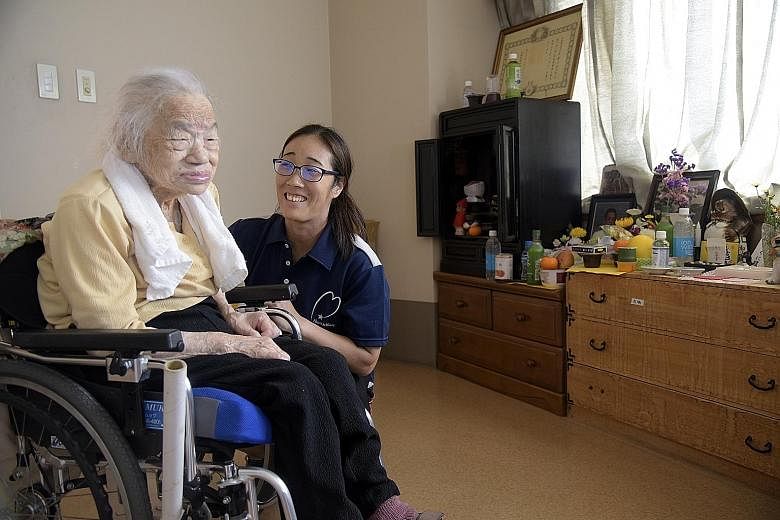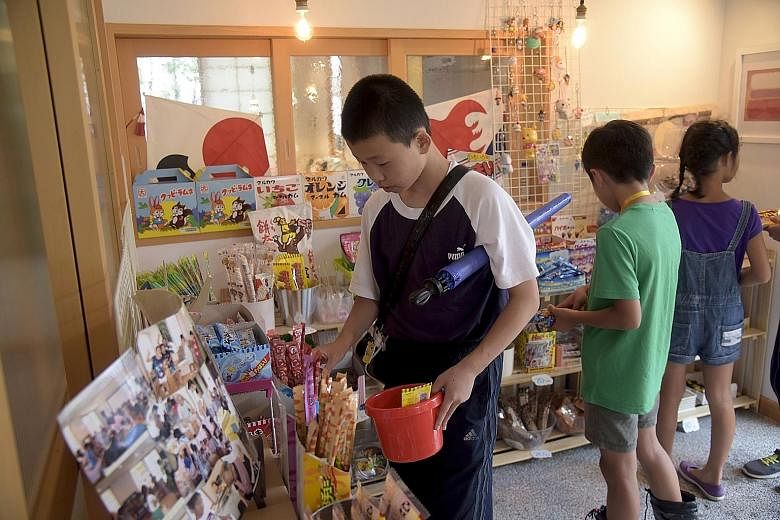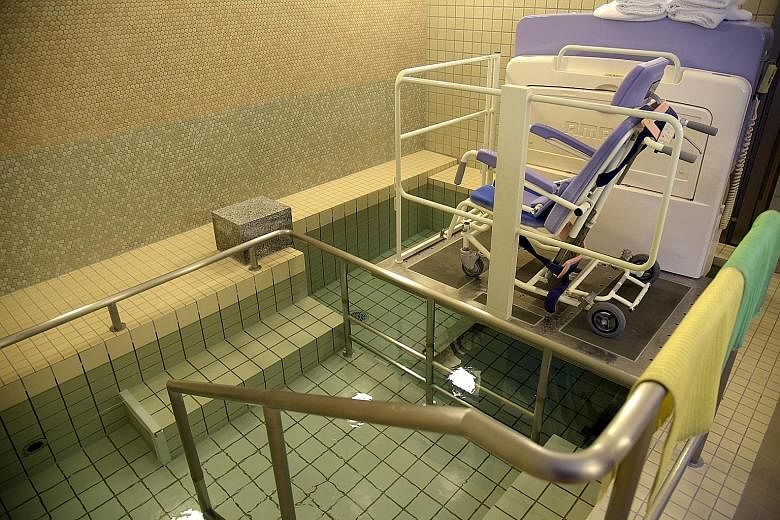The part of her room which Ms Kuni Kuriyama likes the most is a 5m-long stretch of wooden cabinets below the windows.
On them, the 100-year-old displays the items that she holds dear.
On one end stands a miniature altar dedicated to her late husband. Next to it are photos of her two sons. Flowers as well as cat and dog figurines jostle for space along the cluttered tabletop.
"I wanted to bring even more things from home but one of the staff saw them," said Ms Kuriyama with a chuckle.
She has been living in the Sakura nursing home in Tokyo, Japan, for the last six years. Home used to be a condominium unit she shared with one of her sons, and she worked as a home helper for older folk until heart problems compelled her to retire at 70.
Now, the time has come for the former care worker to be cared for.
"This is where I will die," said Ms Kuriyama, her mood turning sombre as tears rolled down her cheeks.
She lives in a tokuyo - what the Japanese call a typical intensive care nursing home.
For a monthly fee of about $1,500, she gets her own room. The staff encourage residents to decorate the rooms with their own furniture and personal items so that they will feel at home in the facility.
In 1991, only half of the tokuyos in Japan had such a practice. Research showed that most homes do it now, as having one's possessions nearby can mitigate the elderly's psychological stress when they move to a new environment.
Nursing homes in Japan have also made the shift from ward-like settings with six or four beds in a room to single rooms over the last decade as studies have shown that single rooms enable a better quality of life for seniors (see other story). In the 1970s, six beds in a room was the norm. This changed to four-bedders by the 1990s. From the year 2000 onwards, single-bed rooms became the mainstay.
QUALITY OVER QUANTITY
These are some key ways in which the nursing care sector in Japan has evolved to preserve its quality of care even as the hyper-ageing society ramps up its eldercare facilities.
A quarter of its people are 65 or older now. By 2040, this group will make up more than a third of its population. Growing in tandem is the number and types of long-term senior care facilities available in Japan.
The most common is the tokuyo, a publicly funded facility that provides nursing care to seniors who have serious physical or mental disabilities. There were 566,600 beds in these facilities last year, up from around 300,000 in 2000.
The number of beds in group homes for those with dementia has also surged from some 10,000 in 2000 to 190,100 last year. There are also about 612,000 beds in private housing with optional care services that are leased to seniors.
In the last decade, a competitive market of service providers, mostly private players, has sprung up. This is largely due to the introduction of Japan's long-term care insurance (LTCI) system in 2000.
LONG-TERM CARE INSURANCE
Family members have traditionally cared for the elderly but nursing homes became affordable with the LTCI. Such a system is designed to shift the responsibility of supporting the elderly away from the family and into the public domain.
This is key as more of the elderly were requiring long-term care, and for longer periods. Yet, there was a lack of adequate caregiver support.
The principles of this system include: supporting the independence of the elderly rather than just providing care, and allowing users to benefit from a range of services from institutions of their choice.
Part insurance-based and part tax-funded, the scheme operates alongside its healthcare system. When people turn 40, they have to start contributing to LTCI, usually around $50 to $70 a month.
On turning 65, they may get a range of support, from home-based help to residential respite, intermediate and long-term care. Depending on their needs, they are then given allowances that the care manager assigned to them can tap as he plans for the type of facility and services for them.
The resident pays only 10 to 20 per cent of the care costs, with costs like housing, food and utilities borne separately by him.
PRESERVING IDENTITY AND AUTONOMY
At Madoka Kawaguchi in Saitama prefecture, the elderly and their family members go through an interview before the seniors are admitted into the home.
This allows the staff to discern the personalities, hobbies and preferences of the seniors to help them adjust better to their new home.
While many of the residents in Madoka are in wheelchairs, that has not stopped the home from trying to replicate the bath experience, as many Japanese like their baths.
There is a platform above a large pool that can lower a wheelchair user into the water. Those who are too weak to use a wheelchair can lie on a "bed" that is filled up with water.
The home tries to make eating more enjoyable as well. In a regular nursing home, solid foods are blended into a mush and agents like corn flour are added to liquids to make them easier to swallow. But this hardly whets the appetite.
At Madoka, food is blended but bean powder is added to shape the mush into its original form, such as slices of salmon.
Some homes also allow residents to come and go as they please. At Ginmokusei Nishiarai, a private residential home for the elderly with optional care services, the doors are not locked. Seniors pay about $2,000 a month for a single room.
Residents with dementia sometimes get lost, noted Mr Tadamichi Shimogawara, president of Silverwood, which runs the facility. "But the elderly go out because they are not used to the place, and do not consider it home. There is always a purpose and meaning behind certain behaviour. Restraining the behaviour of a person simply because it may be 'dangerous' is, in a way, an abusive act. It is important that the elderly go out... and neighbours start to recognise them."
He also lets the elderly decide what they want in the facility. A lady with dementia wanted to have a "dagashi" shop, or a traditional candy shop. They created one as it brought back memories for the elderly. When children drop by to buy sweets, the old and young interact.
RELOCATION DAMAGE
Another key principle that some eldercare facilities in Japan subscribe to is helping the elderly remain in the same place or environment as much as possible.
"When the place they live in changes, there is 'relocation damage'. Their quality of life drops," said Mr Shimogawara. That is why many centres or homes have services from day care and nursing care to end-of-life care.
At Life and Senior House Ribbon City Kawaguchi, 40 apartments on the third, fourth and fifth floor are for those who do not require care yet. When they become frail, they can move down to the second floor where the nursing care rooms are.
Residents each pay $2,000 monthly for a single apartment at the Life House for independent living, on top of a deposit. Those using nursing care at the Senior House pay $2,300 monthly for a single room, on top of a deposit.
Ms Reiko Asano, 82, moved into a single room at Ginmokusei Nishiarai last year. "This room has a balcony and that is a luxury," she said. "I used to bring up my grandchildren but they are all grown up now... so I need to think of my own life."
INNOVATION
The elderly can also opt for cheaper public facilities such as Sakura, which is run by a non-profit organisation. It offers services including nursing care, day care and hospice care for the elderly and disabled.
As residents pay only $600 to $1,600 a month, it has a waiting list of 133 people. This means an average wait of three years to get in.
Despite its low price point, the home offers innovative services.
Every month, it sets up a room for seniors to relax in. They turn up in their wheelchairs at a dimly lit room filled with scents, soothing sounds and calming images projected on a screen. They can then rest or doze off. This form of "snooze" therapy has taken off in hospitals and nursing homes in the United States because of its ability to relax and stimulate patients with dementia.
CHALLENGES
The Labour Ministry estimates one-seventh of Japan's unfilled jobs are in nursing care. This gap will swell as the number of seniors with nursing care needs hits seven million by 2025, up from more than 5.5 million today.
Due to the lack of care workers, some nursing homes are unable to take in more seniors. In 2013, some 524,000 people nationwide were on the waiting list for a spot in a tokuyo. At least 15,000 elderly people resorted to living in unauthorised nursing homes last year.
Japan's cost in caring for the elderly is slated to more than double to 19.8 trillion yen (S$260 billion) in 2025 compared with 2012, with the government footing about half of the bill. Japan already has the world's biggest debt burden. As the population ages, the proportion of tax-paying workers will decrease.
"This is a very dangerous situation financially but the long-term care insurance system can support many elderly people," said Dr Jun Sasaki, chief executive officer of Yushoukai Medical Corporation, the largest home care clinic group in Tokyo. "It's a difficult balance to strike."
WATCH THE VIDEO
How do the elderly in Japan soak in baths in their wheelchairs, and do they have an alternative to mushy, blended food in nursing homes? Seow Bei Yi and Janice Tai visit nursing homes there to find out. http://str.sg/4SXr



